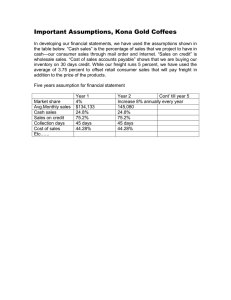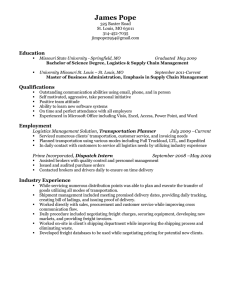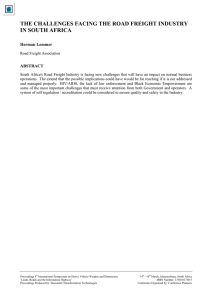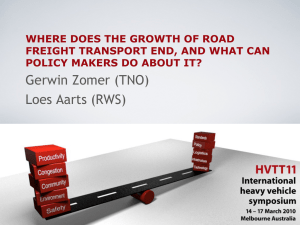The Platform Firm Flexport: Benefitting from its cluster and the... production KELSEY HUTCHERSON
advertisement
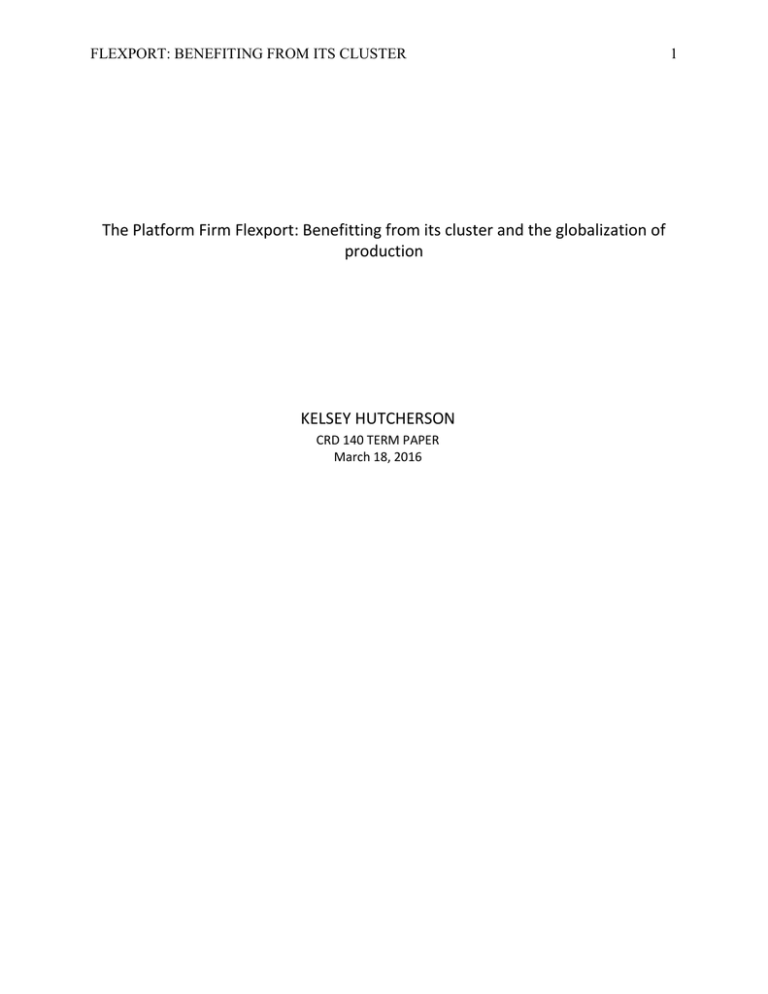
FLEXPORT: BENEFITING FROM ITS CLUSTER The Platform Firm Flexport: Benefitting from its cluster and the globalization of production KELSEY HUTCHERSON CRD 140 TERM PAPER March 18, 2016 1 FLEXPORT: BENEFITING FROM ITS CLUSTER 2 Introduction The transportation and logistics sector is being transformed by the Internet. Roughly $8.3 trillion is spent on logistics every year globally but the industry still relies on faxing papers, spreadsheets, and other means of organizing and keeping track of shipments. However, entrepreneurs have been launching firms meant to “platformize” the shipping industry. In this paper, I analyze a recently formed San Francisco firm, Flexport, a company developing a platform to reinvent global logistics. Flexport is among many other companies in the Silicon Valley and San Francisco area that using the new digital technologies to revolutionize the traditional methods of work by providing a web-based platform for their customers. As part of the “platform economy,” Flexport provides a software application to assist its clients in managing the complexity of international trade. The platform economy is characterized by the use of big data, new algorithms, and cloud computing (Kenney & Zysman, 2016). The emerging platform economy is reorganizing the structure of the economy and, “opens the way for radical changes in how we work, socialize, create value in the economy, and compete for resulting profits” (Kenney & Zysman, 2016). Firms, particularly new startups, are introducing platform-based thinking to disrupt earlier business models. Flexport is located in the San Francisco “platform economy” cluster. While introducing a new software platform, their business model still requires human intervention to augment their platform. The reliance on human expertise increases the precision of managing the complexity of international trade. Flexport is a licensed, full-service freight forwarder and customs brokerage company that provides air freight, ocean freight, trucking, warehouse and fulfillment, customs brokerage, and cargo insurance for its customers. A freight forwarder acts as an intermediary FLEXPORT: BENEFITING FROM ITS CLUSTER 3 between the shipper and various transportation services. The freight forwarder coordinates with carriers from air freighters and trucking companies, to rail freighters and ocean liners to negotiate the best prices and find the most efficient way to move goods from point A to point B. Flexport also manages all documentation, such as bills of lading, customs documentation, shipping requirements, and regulations for each shipment. Flexport developed a web app that is transforming international trade operations. The app reduces logistical errors, increases visibility and transparency of the supply chain, connects even more nodes along the global value chain by reducing logistical and geographical constraints. In the case of Flexport, their digital platform does not appear to have decreased the number of jobs but rather changes the way the work is done. In this essay, I discuss the transformation of the transportation industry and how it allowed for a company like Flexport to exist. I trace the history of Flexport, situate the firm in terms of an emerging “platform economy” and how it is embedded in the San Francisco Platform Economy cluster, and then shift to the global supply chain and how Flexport is benefiting and facilitating from the globalization of production. Transformation of the Transportation Industry The transportation and distribution industries have a long history, but I single out one of the most drastic changes in the way goods were moved prior to the Internet: containerization. Prior to containerization, loading and unloading ships was slow and inefficient. Ships would stay in ports for multiple days and even weeks waiting to get loaded or unloaded. According to Stewart Taggart “only four decades ago, contemporary photos of Singapore’s port showed shirtless workers stumbling down wooden gangplanks carrying enormous bundles of bananas on FLEXPORT: BENEFITING FROM ITS CLUSTER 4 their backs. It was called break-bulk shipping” (1999, p. 2). Malcom McLean, a trucker from North Carolina, revolutionized the transportation industry by introducing the container. McLean created the standardized international shipping we know today: goods put into containerized units that are commonly 8 feet wide, 8.6 feet tall, 20 or 40 feet long, and weighing up to 20 tons (Taggart, 1999, p. 1). The international shipping-unit standardization combined with the falling global tariffs and the reduction in freight transport costs contributed to an increase in world as the movement and transport of goods to consumers significantly quickened, while declining in cost. The containerization revolution created a more efficient and organized system in which it became easier to track, load and unload, and move goods around the world both by sea and by land. The containers are easier to stack and move on and off the ship. Moreover, the placement of each container was such as to to minimize the unloading and loading time in the port. The increased efficiency allowed for more goods to be transported and traded due to the decreased costs of international trade. Containerization also led to reduced transportation costs due to the efficiency and thereby reduced the geographical constraints that previously inhibited goods import and export. This increased efficiency allowed ever more nodes to be connected in the global supply chain. The evolution of postwar shipping and transportation can be separated into three stages: the containerization of 1956, the intermodal system that increased the incorporation of trucks and trains with ocean liners via the use of “intermodals,” and third stage which was the use of electronic data interchange and the Internet that is “marked by ubiquitous data about all goods in the supply chain, from factory to cargo ship to warehouse to retail store” (1999, p. 6). FLEXPORT: BENEFITING FROM ITS CLUSTER 5 Flexport is building a fourth stage based on the implementation of the third stage. The use of the Internet and the increase in the creation of software and web applications that characterizes the “platform economy” helped pave the way for Flexport. To illustrate the changes, Hans Hickler, the Vice President of Consumer Support for American President Lines (APL), a company that provides shipping and transportation services, stated that “the difference between companies will come from services outside of basic transport” (Taggart, 1999, p. 6). Shipping and transportation companies will be pressured to evolve to accommodate this fourth stage and provide logistical services either exclusively or in addition to their transportation services. Bill Villalon, the head of APL’s Global Marketing division, suggests that “the Internet allows for real-time gathering and dissemination of information on both the supply and the demand side” (Taggart, 1999, p. 7). This capability has paved the way for companies to specialize in third-party logistics (3PL) or freight forwarders, like Flexport, to form. This transformation of transportation providers into logistics firms is due to their ability to choreograph the movement of the product, but more importantly, the movement of the information about the product. Traditionally, the 3PL and freight forwarding companies subcontract the transportation portion of the supply chain to transportation companies and coordinate the transportation with them on behalf of their customer. This has allowed for increased synchronicity and choreography in the transportation and logistics sector that characterizes this new stage in the global transportation system. The rise of the logistics sector from the newly-efficient transportation system has created new work, new jobs, and new services. Providing the “information” portion of the transportation industry is a significant source of profit. Doug Coates, part of Manalytics International, a FLEXPORT: BENEFITING FROM ITS CLUSTER 6 company providing consulting services in transportation, logistics, and supply chain management, says “if you don’t have the service, you’ll be eliminated before you get to the ballgame” (Taggart, 1999, p. 8). The question then becomes: how does the Internet further reduce costs in the transportation industry? Taggart (1999) argues that the introduction of the “information” of transportation is as important as or more important than the transportation itself and has completely shifted the industry in a new direction. Since containerization, the importance of this shift lies in “the introduction of systems and insights produced by digital networking” (p. 8). Today, people take for granted how fast their product arrives at their front door and do not think twice how they arrive; their sole concern is how soon their product arrives and the reliability of the service. The saying “time is money” is paramount in many contemporary value chains aa it is imperative that the product or right part of the product gets to the right place at the right time. Disruption in the entire value chain, can cause logistics and transportation firms experience this pressure and being forced to evolve in order to accommodate the trends in consumer preferences by continuing to shorten delivery times, increase transparency of the transit process, and to provide even lower costs. Flexport coordinates with logistics firms that provide these services in order to coordinate the flow of goods and information about the goods and transportation between the suppliers, retailers, and the consumers. In the case of Flexport, not owning their own transportation is an advantage. This allows them to negotiate the best rates for carriers through their web-based platform. Their platform further integrates the “fragmented” system. Flexport’s flexibility in negotiating and choosing the best rates allows them to find the most efficient and economic route, hence the name Flexport. FLEXPORT: BENEFITING FROM ITS CLUSTER 7 The integration of software to help navigate and increase efficiency of international trade has been discussed since the 1960s, but no company has been able to do it as efficiently as Flexport. Fred Smith, now the CEO of FedEx stated that “advancements in information technology would stimulate demand for a totally new kind of logistics system – a system that could replace physical inventories by moving packages of hardware almost as fast as a computer moves packets of data” (Lappin,1996, p. 2). When the system becomes digitized, turning “paperwork into pixels” increases the efficiency and reduces costs even further (Lappin, 1996). Flexport provides improved access and visualization of data through development of a software “dashboard” simplifying he ability of its users to understand the status of their products in the supply chain. The three main advances in the transportation industry: the containerization revolution, the deregulation of the transportation industry, and the Internet, provided the foundation upon which Flexport could introduce a product/slash service that might reinvent the way global trade is organized. Ryan Petersen, the founder and CEO of Flexport, believes that the Cloud can hold ubiquitous data and his success in raising money in order to compete has resulted in Flexport becoming the first freight forwarder to use a modern web platform in order to manage the complexity of international trade. In the next section, I examine the emergence of Flexport, and role of its founder, Ryan Petersen. Company History Flexport in March 2013was founded by Ryan Petersen, now the CEO, Petersen graduated from the University of California, Berkeley, with a B.A. in Economics. Petersen had been interested in international trade, and upon graduation, he traveled in a number of developing FLEXPORT: BENEFITING FROM ITS CLUSTER 8 countries. Fortunately for Petersen, his older brother had already started a business that imported products from China and sold them on the Internet: an ecommerce type of business. According to a Forbes article, the Petersen brothers “sold everything from scooters and dirt bikes to toilets and sinks” (Rogers, 2016). They soon came to be experts at mastering ecommerce websites, optimizing and strengthening search engine capabilities, recruiting online ads, and building userfriendly ecommerce websites (Rogers, 2016). Their firm eliminated middlemen making it possible for customers to buy directly from the source. This arrangement benefits both the supplier, who retain more of the profit, the customer, and the business. Eventually, Petersen went to China to manage the company’s supply chain more closely. While Petersen was in China, he gained insight into the complexity of international logistics operations and how difficult it was to move freight from A to B. He stated in a Forbes article, “We learned what a pain it was to move freight internationally and clear things through customs, make sure that you meet all the compliance regulations, and frankly, figure out where your stuff is and when it’s going to arrive and how much it’s going to cost you and not get ripped off” (Rogers, 2016). Petersen also discovered that all of the shipping documents, such as the bills of lading that contain information about goods entering the U.S., were still in paper form, and the systems being used for tracking etc. were archaic and inefficient. He believed that the application digital technologies could provide a superior and more efficient way of organizing and analyzing them. So he and his brother acquired the entire database of 300 million documents, which they digitized and entered into a searchable database. With this, they sold subscriptions to firms interested in accessing the data. This was incorporated into a firm named ImportGenius.com, which was based in Arizona. FLEXPORT: BENEFITING FROM ITS CLUSTER 9 Though ImportGenius was a step toward digitizing international trade, he believed there was more to do to increase the efficiency and make it easier to transport goods globally. Petersen founded Flexport in March 2013 as a spin-off of ImportGenius. Flexport began operations as a freight forwarder with the intent of automating and simplifying global trade by using software. In 2014, Flexport entered Y Combinator The success of Flexport is due to Petersen’s entrepreneurship, the right timing regarding the transformation of the transportation industry, deregulation of the industry, and the cluster it was founded in. At Flexport’s founding in March 2013, the company consisted of Petersen and one customs broker. By August of 2014, the company expanded to thirteen people and they had signed 700 companies. In 2016, they had nearly 100 employees and were searching for a larger office as they were expanding rapidly due to an increased number of clients. They opened an office in Amsterdam and Hong Kong, and the newest office recently opened in New York (see Figure 2 below). The Flexport Europe office in Amsterdam allows for Flexport to serve the European market and attract other clients and other destinations. Amsterdam is very close to the largest port in Europe, Rotterdam. In 2010, the Port of Rotterdam handled 11.1 million TEUs (20-foot equivalent units) of containerized cargo, according to the World Port Source website. As well as being near the largest port in Europe, the Netherlands is an international hub for international trade, which makes it an ideal location for Flexport to occupy. Similarly, Hong Kong also provides the ideal location for Flexport’s Asian office. in 2014 Hong Kong handled 22.2 million TEUs of containers in 2014 and, of course, is the gateway to China the world’s largest source of international sea cargo. The newest office is in New York, which is also a strategic shipping hub. According to the Port Authority of New York and New Jersey website, “the Port of New York and New Jersey FLEXPORT: BENEFITING FROM ITS CLUSTER 10 is the largest port on the east coast, and the third-largest port in the United States.” It handled just under six million TEUs of containers in 2014. Securing these international and national markets is part of a plan to offer products and services in order to serve some of the largest shipping markets in the world. Figure 2: Showing Flexport’s offices. Source: Flexport, LLC Certifications Flexport is a fully-licensed and full-service freight forwarder and customs brokerage company. In 2013 and 2014, their customs brokerage service was provided by their whollyowned subsidiary, CHQ Brokers LLC, a licensed customs brokerage with a national permit. There was no mention of licensed freight forwarding services or trucking certifications until 2015 and 2016, respectively. In 2015, the customs brokerage service provider changed from CHQ Brokers LLC to Flexport LLC. They then noted that their international ocean freight forwarding service was provided by Flexport International LLC, a licensed non-vessel operating FLEXPORT: BENEFITING FROM ITS CLUSTER 11 common carrier (NVOCC). Later in 2015, they listed that they were a licensed federal motor carrier which licensed their US trucking freight forwarding services. They received their license from the U.S. Department of Transportation, located right near them in their San Francisco cluster as shown in Figure 1 below. The Cluster: The San Francisco Bay Area Figure 1: Showing Flexport’s cluster in San Francisco Flexport’s headquarters is located in the San Francisco Financial District. There are a few other customs brokerage, freight forwarding, transportation and logistics firms, in the vicinity, as shown in Figure 1. However, since the company’s backbone rests on their software platform, their location is strategically in the software and technology hub: the San Francisco Bay Area. Ryan Petersen believes they have the best software engineers in Silicon Valley. At this point, they do not outsource any of their software engineering to countries like India to save costs, all development occurs in-house. The software engineers are situated right next to the logistics experts in Flexport’s open office format. Having the two together in the same space allows for FLEXPORT: BENEFITING FROM ITS CLUSTER 12 problems to be addressed immediately and encourages the creation of a system that works well from both a logistical standpoint and a software standpoint. Petersen avers, “no one is ever going to put these two aspects together better than we have” regarding the intersection of people and software in order to tackle the complexity of international trade. As well as attracting Silicon Valley software engineers, they also attracted top investors that include Peter Thiel’s Founders Fund, First Round Capital, Google Ventures, Y Combinator, and Bloomberg BETA, among others. They have raised $26.6 million so far. Petersen attributes his success in fundraising to his previous stint and entrepreneurship with ImportGenius. One key success, out of the many key successes that Flexport has, is the entrepreneurship of Petersen and his ability to address the inefficiencies in the transportation and logistics industries. The Reasons for Flexport’s Success Flexport refers to itself as the “global logistics control tower in the cloud” (Flexport website, 2015). When companies use Flexport as their freight forwarder and customs brokerage company, they gain access to a network of service providers, custom supply chain visibility, a simple dashboard, and a team of Flexport logistics experts that are on call to assist every step of the way to reduce error rates, provide excellent service, reduce costs, and enable app transactions. The Flexport product allows users to request, negotiate and book shipments through the platform, track their freight movements in real time, have increased transparency regarding pricing, an ability to pay within the app, and manage and analyze product data. Their web-based platform automates shipping, and more importantly, it improves the user experience making it easier for companies of all sizes to engage in international trade. FLEXPORT: BENEFITING FROM ITS CLUSTER 13 Petersen states in the Forbes article that Flexport has 600 customers who use its software and services to organize significant parts of their supply chain (Rogers, 2016). He also noted that since Flexport was founded in March 2013, they have increased revenue by 25% each month (Rogers, 2016). Customers are attracted to the platform that Flexport provides because of the simplified dashboard that eliminates errors, reduces user time, and enhances user experience. The intersection of software and people on their platform helps organize the complex industry like international trade. The product can also be customized for each specific client and each specific supply chain which allows for transparency and increased visualization and control over the supply chain helping customers identify cost savings and working capital optimizations. Flexport states on their website that their aim is to, “put ‘your’ supply chain on autopilot through a fullymanaged service that responds to the demands of your business in real time.” (Flexport website, 2015). Though the software platform is one of their biggest services, it also is one of their biggest challenges. Determining and executing the scale of their platform has been one of their biggest challenges. There is a steep learning curve, and they have undergone significant trial and error learning in order to design the best process. In order to do this, they must interact and connect with other firms in the industry, however their software is incapable of communicating with the software or lack of software of other firms. On the consumer side, they need to develop the best way for their customers to use their interface to make it simple for even first time importers or exporters. They try to replicate real-world challenges and solve them within their web-based platform. Petersen is quoted in the Forbes article saying, “We’re getting really good FLEXPORT: BENEFITING FROM ITS CLUSTER 14 at modeling the real world in software, and then using that software to drive better results back into the real world” (Rogers, 2016). Benefitting from the Globalization of Production Without the globalization of production and international trade, Flexport would not exist. Both of these features, globalization of production and trade, are the backbone of the economy today and have allowed a wide range of developing countries to compete in the global market, furthering their growth. Global value-added chains are “the process by which technology is combined with material and labor inputs, and then processed inputs are assembled, marketed, and distributed” (Gereffi et al., 2005, p. 79). Martin Kenney (2004:5) argues that “the decreasing cost and increasing speed and capabilities in transportation and communication networks are the foundations for the expanding reach of global value chains.” This is exemplified by the use of the Internet that works to connect even more nodes within the value chain. For example, information systems processed through a web platform allow for precise tracking, such as tracking garments shipped from Hong Kong all the way to when it is unloaded for the first time at a retail store in Chicago, their destination. This precise tracking decreases both in-transit time and handling costs as ever more products are bought and sold through web interfaces rather than being purchased at the store, increasing the use of the Internet in order to move and trade these products will increase the synchronicity and choreography. When companies, large and small, participate in international trade, they are able to grow their business and reap the benefits of regional development in their area. The world is continuing to become more interconnected, and the more efficient the transportation system is, the larger the global market may become. Creating a software platform that automates the FLEXPORT: BENEFITING FROM ITS CLUSTER 15 complexity and logistics of international trade has allowed Flexport to differentiate itself from the other freight forwarders and will revolutionize the way global trade operates. Conclusion As we have seen, the transformation of logistics, including the container revolution, deregulation of the transportation industry led to the shift of the tracking of information to the Internet and Cloud. It is this environment of change that allowed Flexport to be established and grow. Flexport’s global advantage lies in an ability to successfully integrate people and software to manage the complexity of international trade and reduce the logistical and geographical constraints, connecting ever more nodes in the global value chain. The key to this is web-based software platform that increases efficiency and makes the user experience more seamless. These benefits are what Flexport believes will allow it to attract a larger client base. From a platform perspective, their key challenge will be to attract more firms to their platform and integrate their software into the Flexport platform. References Air Freight. Flexport, LLC [website]. Retrieved from https://www.flexport.com/services/freight_forwarding/air_freight About Us. Flexport, LLC [website]. Retrieved from https://www.flexport.com/about The Blueprint Talks With: Ryan Petersen, Founder & CEO at Flexport. (August 14, 2014). Retrieved from https://theblueprint.com/stories/ryan-petersen/ FLEXPORT: BENEFITING FROM ITS CLUSTER 16 Gereffi, G., Humphrey, J., & Sturgeon, T. (2005). The governance of global value chains. Review of International Political Economy 12:1, 78-104. Global Forwarding. Flexport, LLC [website]. Retrieved from https://www.flexport.com/services/freight_forwarding Hong Kong Port Development Council. (2015). Retrieved from http://www.pdc.gov.hk/eng/facilities/port.htm Kenney, M. (2004). Locating Global Advantage: Industry Dynamics in the International Economy. Stanford, CA: Stanford University Press. Kenney, Martin, and John Zysman. "The Rise of the Platform Economy." Issues in Science and Technology 32, no. 3 (Spring 2016). Lappin, T. (2000). The Airline of the Internet: FedEx is piloting the next phase of the Digital Revolution. It's a very big idea. It's called logistics. The Condé Nast Publications Inc. Ocean Freight. Flexport, LLC [website]. Retrieved from https://www.flexport.com/services/freight_forwarding/ocean_freight Port of New York and New Jersey. About the Port. Retrieved from http://www.panynj.gov/port/about-port.html Rogers, Bruce. (February 25, 2015). Ryan Petersen’s Flexport Aims to Simplify Global Freight Transport Business. A Series of Insight Profiles of Thought Leaders Changing the Business Landscape: Ryan Petersen, Founder and CEO, Flexport. Forbes.com. Retrieved from http://www.forbes.com/sites/brucerogers/2016/02/25/ryan-petersens-flexport-aimsto-simplify-global-freight-transport-business/#280f09a256a2 Taggart, S. (1999). The 20-Ton Packet: Ocean shipping is the biggest real-time datastreaming network in the world. The Condé Nast Publications Inc. FLEXPORT: BENEFITING FROM ITS CLUSTER Trucking and Delivery. Flexport, LLC [website]. Retrieved from The Blueprint Talks With: Ryan Petersen, Founder & CEO at Flexport. (August 14, 2014). Retrieved from https://theblueprint.com/stories/ryan-petersen/ Why Flexport. Flexport, LLC [website]. Retrieved from https://www.flexport.com/benefits World Port Source. Port of Rotterdam. Retrieved from http://www.worldportsource.com/ports/commerce/NLD_Port_of_Rotterdam_106.php 17
